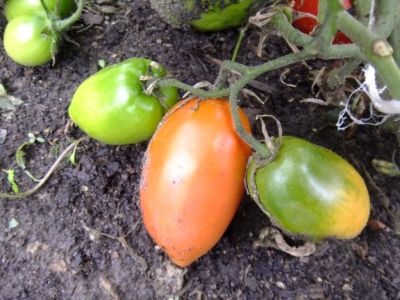
- Authors: Gavrish S.F., Morev V.V., Amcheslavskaya E.V., Degovtsova T.V., Volotok O.A.
- Year of approval: 2015
- Category: grade
- Growth type: indeterminate
- Appointment: fresh consumption, for juice
- Ripening period: late ripening
- Ripening time, days: 120-130
- Growing conditions: for film greenhouses
- Bush size: tall
- Bush height, cm: from 183
Bloody Mary is a hybrid tomato variety bred by Russian breeders and approved for use in 2015. As the name suggests, this variety is perfect for making the Bloody Mary cocktail.
Description of the variety
The plant is an indeterminate tall bush, the height of which reaches at least 183 cm. The leaves are large, their color is green or dark green, the inflorescence is simple.
The main qualities of the fruit
When unripe, tomatoes are light green in color, while ripe fruit is red. Tomatoes are quite large in size, their weight is 260-350 g. In shape, they are cuboid, ribbed. Inside there is a pulp of medium density.
Taste characteristics
The fruits have good taste and are often used for fresh consumption. Also, tomatoes are often used to make juice, from which the cocktail of the same name is then prepared.
In a cool place, the fruits can be stored for a long time without changing the taste characteristics, they are also characterized by good transportability, therefore, the tomatoes of the presented variety are suitable not only for growing on a private plot, but also for cultivation on an industrial scale for commercial purposes.
Ripening and fruiting
The Bloody Mary is a late-ripening variety. The first tomatoes can be enjoyed 120-130 days after the first shoots appear.
Yield
It is a high-yielding variety capable of producing 10-12 kg / sq. m.
The timing of planting seedlings and planting in the ground
Seedlings are sown in March and early April. Prepare the substrate before sowing. It can be made by mixing turf soil, humus and washed river sand in a ratio of 2: 2: 1. You can purchase a ready-made composition in the store. The process of planting and caring for seedlings is as follows.
- Pour the prepared soil into a container and compact slightly. Sprinkle with warm water from a spray bottle.
- Deepen the seeds 1.5 cm and spray again with water.
- Cover the container with plastic wrap and leave in a dark place.
- Remove the film as soon as the first shoots hatch, and place the container in a bright place.
- Water the seedlings as needed and feed them with compound fertilizers.
- When two leaves appear, dive the seedlings and continue leaving.
- A week before transplanting to a summer cottage, begin to harden the plants, that is, take them out into the fresh air, increasing the time spent outdoors every day.
- Seedlings are planted in early-mid-May or late May-early June.

Growing tomato seedlings is an extremely important process, because it largely depends on whether the gardener can harvest at all. All aspects must be taken into account, from seedbed preparation to planting in the ground.
Landing scheme
For 1 sq. m have 6-8 plants, that is, the distance between the specimens should be 30-40 cm.For a high yield and mass ripening, the recommended distance is 50 cm.

Growing and care
The Bloody Mary variety is grown in plastic greenhouses, but in some regions it is allowed to cultivate tomatoes outdoors, but keep in mind that in this case the fruits will be much smaller in size and the yield will be lower, although this will not affect the taste in any way.
The main care is to water the crop. Irrigate the soil with warm, settled water in the evening as the soil dries out. To reduce the amount of watering, lay a layer of mulch around the bushes to help trap moisture in the soil. Tomatoes are fed twice - before flowering and before ripening of tomatoes.
Also, the plant needs to be pinned and tied to a support. The most effective way to form is in 2 stems.
Reviews
Most of all, consumers praise the appearance and bright taste of the fruit. According to gourmets, the skins of the tomatoes are sprinkled with salt and pepper, which reminds of the famous cocktail. The delicate aroma of fresh vegetables is noted. Summer residents highly appreciate the unpretentious care and high yield of the Bloody Mary variety.




A plant needs different micronutrients at each stage of growth. All fertilizers can be divided into two groups: mineral and organic. Folk remedies are often used: iodine, yeast, bird droppings, eggshells.
It is important to observe the rate and period of feeding. This also applies to folk remedies and organic fertilizers.



























































































